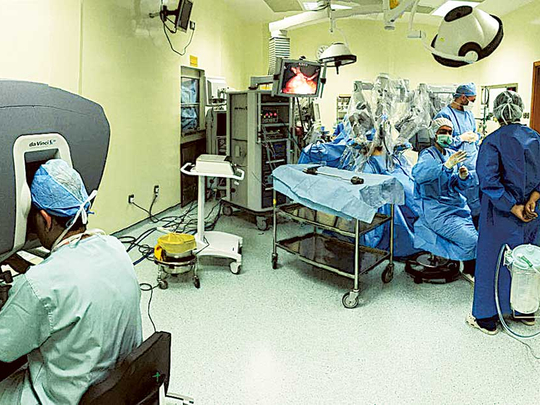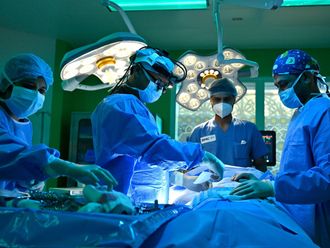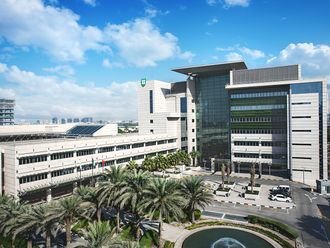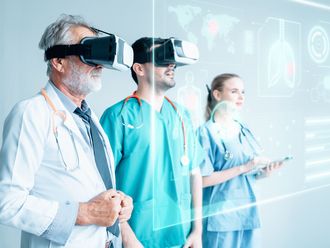
Sharjah: For the first time in the UAE, robotic bariatric surgery that will help surgeons stay in 100 per cent control of the procedure at all times is being introduced at Al Qasimi Hospital in Sharjah.
The Dh13 million da Vinci robot is being used to conduct gastric sleeve surgery and gastric bypass.
The da Vinci system has a magnified 3D high-definition vision and special wristed instruments that bend and rotate to higher degrees than the human wrist to facilitate deeper vision, dexterity and control. This enhanced precision allows surgeons to better observe the site of the stomach and treat the condition with a higher success rate.
Dr Abdul Wahid Al Wahidi, consultant general surgeon, head of the General Surgery Department and deputy technical director, told Gulf News that this is the most advanced gastric sleeve surgery available and requires extensive training, skill and experience on the part of surgeons.
The procedure, the doctor said, is considered to be a first-of-its-kind operation to be conducted without opening the abdomen.
“Robotic weight-loss surgery is less invasive than open surgery. Rather than one long abdominal incision, there are three small incisions — causing less trauma to tissue,” he said. The procedure is also a particularly viable option for severely obese patients due to its increased penetrative vision and dexterity.
Dr Al Wahidi said, “Bariatric surgery is suggested for patients with a high body mass index and other medical conditions related to obesity after all other treatments have failed.”
The patient is advised of this procedure and, if he is amenable, “then we will perform the surgery”, he said.
Six successful weight reductions through this surgery have already been performed at Al Qasimi Hospital.
The Emirati patients comprised four women and two men in the age group of 22 to 50 weighing between 122kg and 150kg. Three incisions measuring not more than 0.cm-1cm each were made on the patient’s abdomen, said Dr Al Wahidi. One incision was for the camera, one for the stabiliser, and the third for the robotic arms to probe the patient’s stomach region.
Using the system, the main surgeon, seated at the console a few metres from the patient, can have his eyes and hands positioned in line with the instruments inside the patient’s abdomen and, with great precision, perform the operation with the help of 15-16 times magnified images of the patient’s gastric system.
“The patients are well and were discharged from hospital with great results.”
Dr Al Wahidi said the surgery’s success ratio is significant because it allows a pain-free recovery for patients as compared to an open-abdomen surgery. Besides the absence of scars, the patients are able to resume their routine quickly, he added.
For UAE nationals, the cost for this procedure is shouldered by the government, Dr Al Wahidi said.
For others, it costs Dh23,000 for gastric bypass and Dh33,000 for sleeve gastrectomy.
Dr Al Wahidi said they are planning to make the procedure to work with just one incision instead of three in the future.
What is gastric bypass surgery
Gastric bypass shrinks the stomach’s size and reroutes the digestive tract. During surgery, doctors divide the stomach sac to create a new, smaller stomach. The new stomach is attached to the small intestine and bypasses the larger part of the original stomach sac. The new stomach will be much smaller — therefore also holding a smaller volume of food.
Gastric Sleeve
During gastric sleeve surgery, also known as sleeve gastrectomy, most of the stomach sac is removed. As with gastric bypass, the smaller, sleeve-shaped stomach that remains is sealed and holds smaller amounts of food.
Advantage of da Vinci system
For surgeon
The da Vinci System gives surgeons a 3D HD view inside the body; wristed instruments that bend and rotate to far greater degrees than the human hand, enhanced vision, precision and control.
For patient
Less pain
Decrease in blood loss
Less scarring.
Fewer complications
Shorter hospital stay
Shorter recovery time
Faster return to normal routine
Better clinical outcome
Challenges of the da Vinci robotic surgery:
Longer learning period for surgeons
High cost of the equipment and maintenance and thereby also for the procedure
Reduction in space for assistants
Lack of tactile sensation for the surgeon












